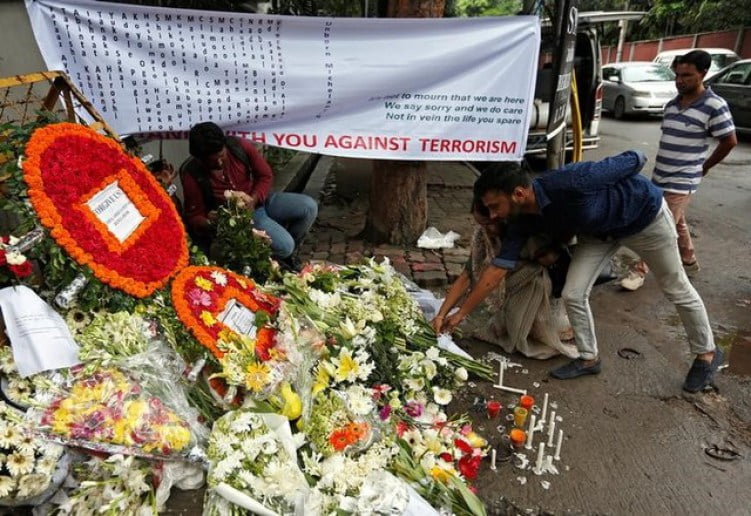
It is time to reevaluate if the Bush-era tactics – fighting violence with greater violence, and erecting security barriers and surveillance regimes everywhere – are adequate or suitable for a country facing homegrown radicals who aspire to represent global terror franchises.

People place flowers at a makeshift memorial near the site, to pay tribute to the victims of the attack on the Holey Artisan Bakery and the O’Kitchen Restaurant, in Dhaka, Bangladesh, July 5, 2016. Credit: Reuters
This Ramadan in Bangladesh, the revered Lailat-ul-Qadr (‘night of power’, which follows the day on which Muslims believe the Holy Qur’an was revealed) was preceded by a night of terror, by those claiming to speak for Islam in a language we do not recognise. The terrorist attack in Dhaka took 26 lives, and has left the city in a stupor and dazed state of heartbreak.
There is talk of vengeance in the air and there is also a call to patience. There are defences of creed and vilification of entire traditions. There is evaluation of the response time and criticism of the PR spin on casualties. But what is missing is clarity.
This is the intended effect of terrorism.
Soon “security analysts,” from CIA to CNN, will have speculated without basis and the media will have eulogised victims for the extra click. A condemnation of the perpetrators, though socially warranted, is self-serving and meaningless. It is a symbolic shield against a real, unsheathed method of propaganda war. The TV audience too is a victim in this and must vent, rationalise, pontificate and console. However, this must not preclude a social response strategy.
The party that is always central to staging a bloody spectacle cannot remain beyond reproach. The performance of the mainstream Bangladeshi media during the attack and hostage standoff was outrageous. Reporters demonstrated zero professional training, no respect for tactical response preparations and little empathy for those thrust in harm’s way. In their frenzied “breaking news” reporting, they sensed the irrepressible public demand for scoops, peeks and gory details.
It is unacceptable that dozens of media channels were allowed to broadcast live from the scene for hours. Despite the subsequent news blackout, images of trucks hauling military landing crafts were being telecast till the next morning. On international media, there seemed to be little monitoring of, or control over, who was speaking for Bangladesh and in what capacity. American audiences were told, repeatedly and incorrectly, that “Bangladesh shared a border with Pakistan,” that it was a “failed state” and that it had “fought wars with India”.
There is no denying that a violent spectacle is as inherently addictive as it is repulsive and that it triggers a macabre voyeurism. So when security experts mushroom all over the screens, social media peddles new theories and op-eds start to reframe the attacks, it is spurred on by the popular demand for meaning making.
This is the target market for terrorism.
It is now much easier to place Bangladesh in the radicalisation map and the global Islamist terrorism narrative. Countless theories will emerge. Government loyalists will find anti-liberation elements responsible, while critics will argue (as former US Ambassador William Milam did) that it is the government’s strongman policies that have resulted in a political vacuum and a decimated opposition. Geopolitically, it will be seen as the natural progression as “radicalism” courts the subcontinent. There are those who will see breakdown of family structures and yet others who will find in it the wrath of God. Each of these views is politically inspired and contributes to the bearers’ group interests.
For some years, we have seen the American ‘war on terror’ manual being emulated in Bangladesh, where an ‘other’ is blamed for attacks on ‘us’ and the narrators retain exclusive right to the moral high ground and legitimacy. The strategy, failed elsewhere and still replicated here, is to fight violence with greater violence, and erect security barriers and surveillance regimes everywhere. But have these strategies made the world more stable or safer, or have they destabilised entire regimes and regions in Iraq, Afghanistan, Syria and Libya?
It is time to reevaluate if the Bush-era tactics are adequate, or even suitable, for any country facing homegrown radicals who aspire to represent global “terror” franchises. An important clue may have been revealed when Dhaka security forces announced intentions to negotiate with the gunmen at Holey Artisan Bakery, a departure from the war on terror protocol.
Three of the alleged gunmen went to more privileged English-medium schools and came from affluent backgrounds. Their socioeconomic status was markedly different from that of the groups involved in recent targeted killings of secular activists and religious minorities. They grew up in a liberal Dhaka environment and then something led them to that restaurant wielding automatic weapons. Bloodshed was their only political statement.
Bangladesh is not a fertile breeding ground for radicalism. The key word here is ‘fertile’. There is no historical resentment or unjust wars, as there are in Iraq or Afghanistan. There are no ‘infidel rulers’ or sectarian conflicts. However, there are young minds ready to be moulded, and the war on terror has made ‘global jihad’ a seductive siren call for the mentally unstable, the delusional and the disaffected. Social cracks and an unstable government leave tender emotions to be smelted into violence.
Family sources say that one Bangladeshi hostage was spared his life when he successfully recited from the Qur’an. Faraaz Hossain, grandson of one of Bangladesh’s top industrialists, and an undergraduate at Emory University in the US, had been in Dhaka for Eid holidays. But he refused to leave without his two friends, an American and an Indian, and stayed back in that inferno. In the end, he paid the price with his life; but not before setting an example of and for all Bangladeshis (of all religions), and all Muslims globally. Let him be a reminder that at the end of the day, there’s no morality without courage and no righteousness without mercy.
[Source:- Wire]



